British Airways: Navigating the Complex Business Environment
VerifiedAdded on 2023/04/23
|14
|4882
|239
Report
AI Summary
This report provides a comprehensive analysis of the business environment in which British Airways operates. It begins by outlining the purposes of different types of organizations and assessing the extent to which British Airways meets the objectives of its various stakeholders, including customers, employees, shareholders, suppliers, and the government. The report then examines the responsibilities and strategies adopted by British Airways to satisfy these stakeholders. Further, the report delves into the attempts made by economic systems to allocate resources effectively, evaluating the impact of fiscal and monetary policies, as well as regulatory policies, on British Airways' activities. The analysis extends to the impact of market structures on pricing and output decisions, the ways in which market forces shape British Airways' responses, and the influence of the business and cultural environment. Finally, the report addresses the significance of international trade, the impact of global factors, and the effects of European Union policies on British Airways, offering a holistic view of the airline's operational context.

Business Environment
Paraphrase This Document
Need a fresh take? Get an instant paraphrase of this document with our AI Paraphraser

TABLE OF CONTENTS
INTRODUCTION...........................................................................................................................1
TASK 1............................................................................................................................................1
1.1 Purposes of different types of organizations....................................................................1
1.2 Extent to which British Airways meet the objectives of different stakeholders..............2
1.3 Responsibilities and strategies made by British Airways.................................................3
TASK 2............................................................................................................................................3
2.1 Attempts made by economic systems to allocate resources effectively...........................3
2.2 Impact of fiscal and monitory policies on the activities of British Airways....................4
2.3 Impact of regulatory policies and other regulatory mechanisms of British Airways.......5
TASK 3............................................................................................................................................6
3.1 Impact of market structures in determining the pricing and output decision of BA........6
3.2 Ways in which market forces shape British Airways response........................................7
3.3 Impact of business and cultural environment over British Airways................................7
TASK 4............................................................................................................................................8
4.1 Significance of international trade to British Airways.....................................................8
4.2 Impact of global factors on British Airways....................................................................9
4.3 Impact of policies of European Union over British Airways...........................................9
CONCLUSION..............................................................................................................................10
REFERENCES..............................................................................................................................11
INTRODUCTION...........................................................................................................................1
TASK 1............................................................................................................................................1
1.1 Purposes of different types of organizations....................................................................1
1.2 Extent to which British Airways meet the objectives of different stakeholders..............2
1.3 Responsibilities and strategies made by British Airways.................................................3
TASK 2............................................................................................................................................3
2.1 Attempts made by economic systems to allocate resources effectively...........................3
2.2 Impact of fiscal and monitory policies on the activities of British Airways....................4
2.3 Impact of regulatory policies and other regulatory mechanisms of British Airways.......5
TASK 3............................................................................................................................................6
3.1 Impact of market structures in determining the pricing and output decision of BA........6
3.2 Ways in which market forces shape British Airways response........................................7
3.3 Impact of business and cultural environment over British Airways................................7
TASK 4............................................................................................................................................8
4.1 Significance of international trade to British Airways.....................................................8
4.2 Impact of global factors on British Airways....................................................................9
4.3 Impact of policies of European Union over British Airways...........................................9
CONCLUSION..............................................................................................................................10
REFERENCES..............................................................................................................................11

INTRODUCTION
Business environment refers to sum of internal as well as external factors which influence
the operations of business organizations. However, some external and internal factors can
influence each other which also affect the business (Evans, Stonehouse and Campbell, 2012). For
example, health and safety is an external factor which creates impact over the internal factors of
business firm.
British Airways (BA) is the largest airline based on fleet size in UK and it is second
largest in Britain when measured in terms of passengers. This report will explicate the
environment of British Airways and also the significance of global factors which shapes
activities of the said business concern. Moreover, the report will also justify the outcomes of
policies made by European Union over business organizations of UK.
TASK 1
1.1 Purposes of different types of organizations
Business organizations differ from each other according to their functions, aim and
objectives. It indicates that all business organizations operate their activities with different
purposes. Some of them have been mentioned below: Private sector enterprises: - Private limited companies tend to operate business by
increasing capital through issuing large number of shares. Another main purpose of
Private businesses is to operate the enterprise in such a way that competitors would not
be able to take over the firm easily (Kemp and Dwyer, 2003). Public sector enterprises: - Public limited companies are not owned privately as there is
big role played by government. In other words, influence of regulatory authorities is very
high in public limited enterprises. The main purpose of public limited business is to gain
capital through the capital market. Franchising businesses: - Franchising companies are most probably related with food
products and cloth market. For example, McDonalds and Primark are fast food and cloth
companies respectively. Dealers take franchise with these firms through standard
agreements and contract. However, the main purpose of franchising business is to
minimize the risks and to maintain the global cost.
1
Business environment refers to sum of internal as well as external factors which influence
the operations of business organizations. However, some external and internal factors can
influence each other which also affect the business (Evans, Stonehouse and Campbell, 2012). For
example, health and safety is an external factor which creates impact over the internal factors of
business firm.
British Airways (BA) is the largest airline based on fleet size in UK and it is second
largest in Britain when measured in terms of passengers. This report will explicate the
environment of British Airways and also the significance of global factors which shapes
activities of the said business concern. Moreover, the report will also justify the outcomes of
policies made by European Union over business organizations of UK.
TASK 1
1.1 Purposes of different types of organizations
Business organizations differ from each other according to their functions, aim and
objectives. It indicates that all business organizations operate their activities with different
purposes. Some of them have been mentioned below: Private sector enterprises: - Private limited companies tend to operate business by
increasing capital through issuing large number of shares. Another main purpose of
Private businesses is to operate the enterprise in such a way that competitors would not
be able to take over the firm easily (Kemp and Dwyer, 2003). Public sector enterprises: - Public limited companies are not owned privately as there is
big role played by government. In other words, influence of regulatory authorities is very
high in public limited enterprises. The main purpose of public limited business is to gain
capital through the capital market. Franchising businesses: - Franchising companies are most probably related with food
products and cloth market. For example, McDonalds and Primark are fast food and cloth
companies respectively. Dealers take franchise with these firms through standard
agreements and contract. However, the main purpose of franchising business is to
minimize the risks and to maintain the global cost.
1
⊘ This is a preview!⊘
Do you want full access?
Subscribe today to unlock all pages.

Trusted by 1+ million students worldwide
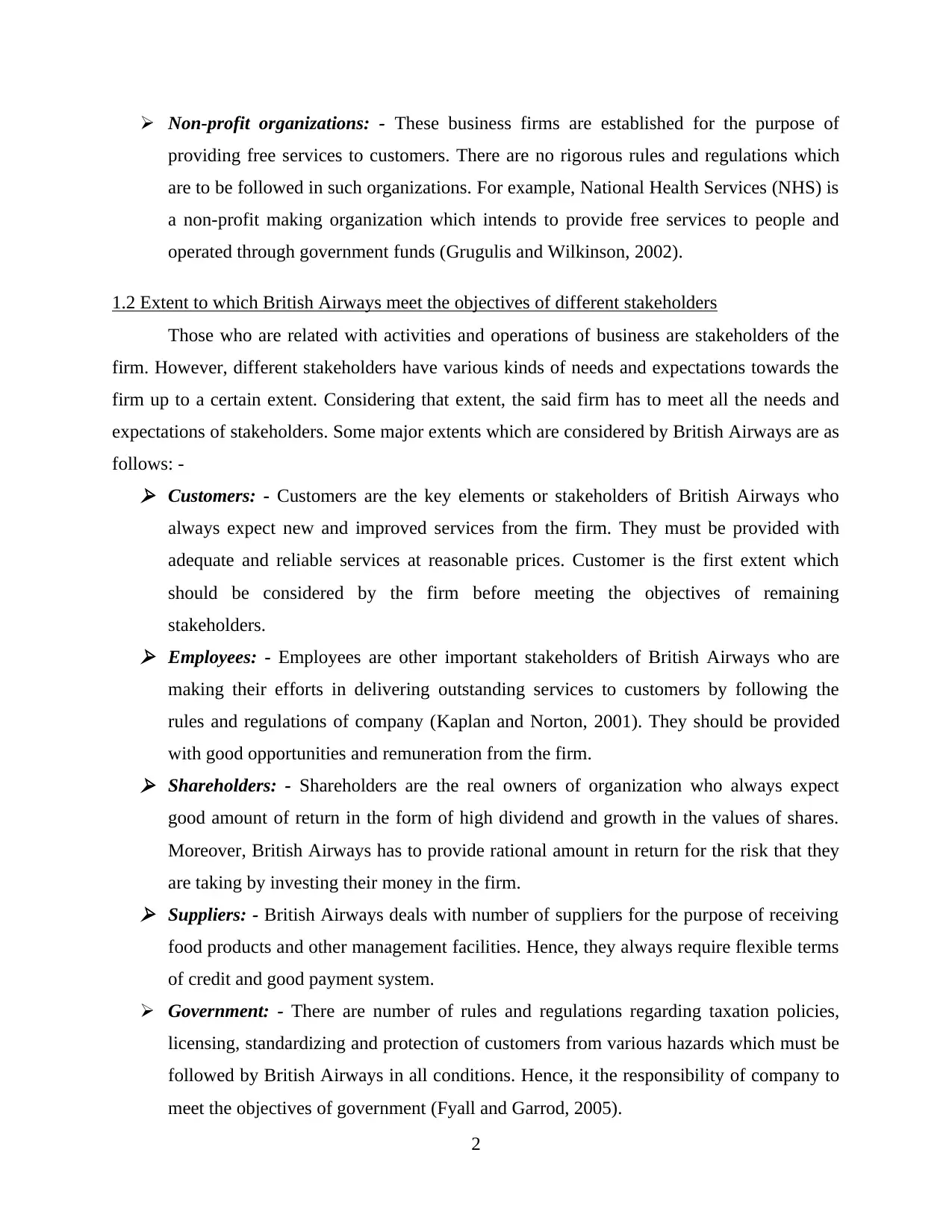
Non-profit organizations: - These business firms are established for the purpose of
providing free services to customers. There are no rigorous rules and regulations which
are to be followed in such organizations. For example, National Health Services (NHS) is
a non-profit making organization which intends to provide free services to people and
operated through government funds (Grugulis and Wilkinson, 2002).
1.2 Extent to which British Airways meet the objectives of different stakeholders
Those who are related with activities and operations of business are stakeholders of the
firm. However, different stakeholders have various kinds of needs and expectations towards the
firm up to a certain extent. Considering that extent, the said firm has to meet all the needs and
expectations of stakeholders. Some major extents which are considered by British Airways are as
follows: - Customers: - Customers are the key elements or stakeholders of British Airways who
always expect new and improved services from the firm. They must be provided with
adequate and reliable services at reasonable prices. Customer is the first extent which
should be considered by the firm before meeting the objectives of remaining
stakeholders. Employees: - Employees are other important stakeholders of British Airways who are
making their efforts in delivering outstanding services to customers by following the
rules and regulations of company (Kaplan and Norton, 2001). They should be provided
with good opportunities and remuneration from the firm. Shareholders: - Shareholders are the real owners of organization who always expect
good amount of return in the form of high dividend and growth in the values of shares.
Moreover, British Airways has to provide rational amount in return for the risk that they
are taking by investing their money in the firm. Suppliers: - British Airways deals with number of suppliers for the purpose of receiving
food products and other management facilities. Hence, they always require flexible terms
of credit and good payment system.
Government: - There are number of rules and regulations regarding taxation policies,
licensing, standardizing and protection of customers from various hazards which must be
followed by British Airways in all conditions. Hence, it the responsibility of company to
meet the objectives of government (Fyall and Garrod, 2005).
2
providing free services to customers. There are no rigorous rules and regulations which
are to be followed in such organizations. For example, National Health Services (NHS) is
a non-profit making organization which intends to provide free services to people and
operated through government funds (Grugulis and Wilkinson, 2002).
1.2 Extent to which British Airways meet the objectives of different stakeholders
Those who are related with activities and operations of business are stakeholders of the
firm. However, different stakeholders have various kinds of needs and expectations towards the
firm up to a certain extent. Considering that extent, the said firm has to meet all the needs and
expectations of stakeholders. Some major extents which are considered by British Airways are as
follows: - Customers: - Customers are the key elements or stakeholders of British Airways who
always expect new and improved services from the firm. They must be provided with
adequate and reliable services at reasonable prices. Customer is the first extent which
should be considered by the firm before meeting the objectives of remaining
stakeholders. Employees: - Employees are other important stakeholders of British Airways who are
making their efforts in delivering outstanding services to customers by following the
rules and regulations of company (Kaplan and Norton, 2001). They should be provided
with good opportunities and remuneration from the firm. Shareholders: - Shareholders are the real owners of organization who always expect
good amount of return in the form of high dividend and growth in the values of shares.
Moreover, British Airways has to provide rational amount in return for the risk that they
are taking by investing their money in the firm. Suppliers: - British Airways deals with number of suppliers for the purpose of receiving
food products and other management facilities. Hence, they always require flexible terms
of credit and good payment system.
Government: - There are number of rules and regulations regarding taxation policies,
licensing, standardizing and protection of customers from various hazards which must be
followed by British Airways in all conditions. Hence, it the responsibility of company to
meet the objectives of government (Fyall and Garrod, 2005).
2
Paraphrase This Document
Need a fresh take? Get an instant paraphrase of this document with our AI Paraphraser

1.3 Responsibilities and strategies made by British Airways
British Airways has number of responsibilities towards its stakeholders. For each and
every stakeholder, the firm has to make effective strategies which can help them to meet their
expectations. Various responsibilities and strategies of British Airways have been mentioned
below: Responsibilities towards customers: - British Airways has to provide qualitative products
and services to 40 million customers every year. This can be done through maintaining
healthy relationship with them through CRM policies. Maintaining good relationship will
increase the loyalty of customers and will also create a positive impact over profitability
of the firm. Responsibilities towards employees: - There are around 40,000 employees working in
British Airways who must get good working environment as well as opportunities for
employment (Button, 2005). By maintaining sound Human Resource Management
policies, performance of employees can be enhanced effectively. Responsibilities towards shareholders: - British Airways holds numerous shareholders
who have invested a huge amount of sum through buying shares of the firm. The
mentioned aviation industry through providing healthy dividends can retain its
stakeholders for the long-run. Moreover, stakeholders can gain information about BA
through its website regarding making investment.
Responsibilities towards environment: - The cited aviation industry has size of around
300 which indicates that each of them emits huge amount of heat and dust particulates in
air (Oum, Yu and Zhang, 2001). It is one of the prior responsibilities of British Airways
to reduce such pollution through controlling devices like dust cyclones, particulate
scrubbers, Baghouses, Wet scrubber etc.
TASK 2
2.1 Attempts made by economic systems to allocate resources effectively
In order to allocate the resources effectively and efficiently, there are number of
economic systems which are followed by the regulatory authorities such as: Free enterprise economy: - In this type of economic system, different types of business
organizations can operate their activities without involvement of government. In other
3
British Airways has number of responsibilities towards its stakeholders. For each and
every stakeholder, the firm has to make effective strategies which can help them to meet their
expectations. Various responsibilities and strategies of British Airways have been mentioned
below: Responsibilities towards customers: - British Airways has to provide qualitative products
and services to 40 million customers every year. This can be done through maintaining
healthy relationship with them through CRM policies. Maintaining good relationship will
increase the loyalty of customers and will also create a positive impact over profitability
of the firm. Responsibilities towards employees: - There are around 40,000 employees working in
British Airways who must get good working environment as well as opportunities for
employment (Button, 2005). By maintaining sound Human Resource Management
policies, performance of employees can be enhanced effectively. Responsibilities towards shareholders: - British Airways holds numerous shareholders
who have invested a huge amount of sum through buying shares of the firm. The
mentioned aviation industry through providing healthy dividends can retain its
stakeholders for the long-run. Moreover, stakeholders can gain information about BA
through its website regarding making investment.
Responsibilities towards environment: - The cited aviation industry has size of around
300 which indicates that each of them emits huge amount of heat and dust particulates in
air (Oum, Yu and Zhang, 2001). It is one of the prior responsibilities of British Airways
to reduce such pollution through controlling devices like dust cyclones, particulate
scrubbers, Baghouses, Wet scrubber etc.
TASK 2
2.1 Attempts made by economic systems to allocate resources effectively
In order to allocate the resources effectively and efficiently, there are number of
economic systems which are followed by the regulatory authorities such as: Free enterprise economy: - In this type of economic system, different types of business
organizations can operate their activities without involvement of government. In other
3
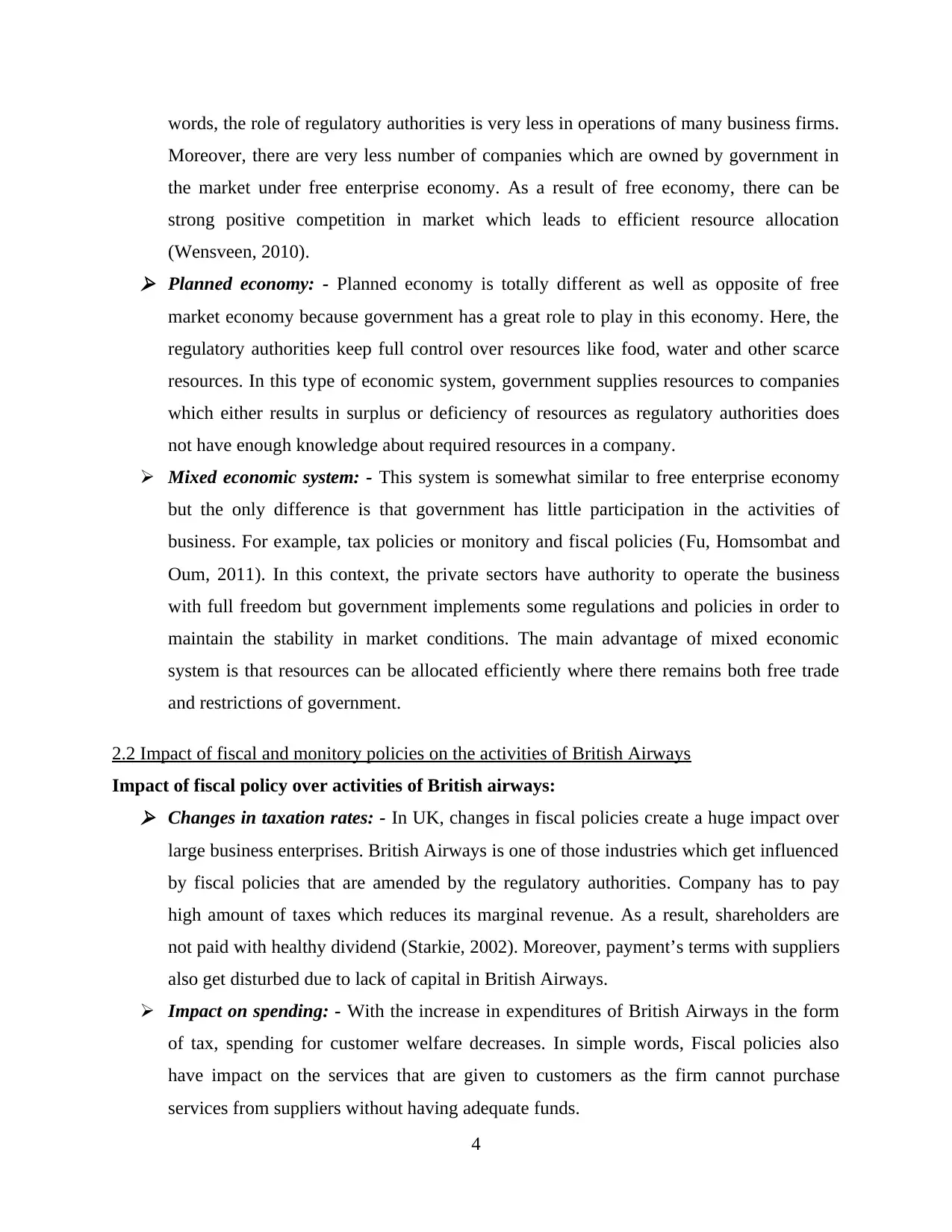
words, the role of regulatory authorities is very less in operations of many business firms.
Moreover, there are very less number of companies which are owned by government in
the market under free enterprise economy. As a result of free economy, there can be
strong positive competition in market which leads to efficient resource allocation
(Wensveen, 2010). Planned economy: - Planned economy is totally different as well as opposite of free
market economy because government has a great role to play in this economy. Here, the
regulatory authorities keep full control over resources like food, water and other scarce
resources. In this type of economic system, government supplies resources to companies
which either results in surplus or deficiency of resources as regulatory authorities does
not have enough knowledge about required resources in a company.
Mixed economic system: - This system is somewhat similar to free enterprise economy
but the only difference is that government has little participation in the activities of
business. For example, tax policies or monitory and fiscal policies (Fu, Homsombat and
Oum, 2011). In this context, the private sectors have authority to operate the business
with full freedom but government implements some regulations and policies in order to
maintain the stability in market conditions. The main advantage of mixed economic
system is that resources can be allocated efficiently where there remains both free trade
and restrictions of government.
2.2 Impact of fiscal and monitory policies on the activities of British Airways
Impact of fiscal policy over activities of British airways: Changes in taxation rates: - In UK, changes in fiscal policies create a huge impact over
large business enterprises. British Airways is one of those industries which get influenced
by fiscal policies that are amended by the regulatory authorities. Company has to pay
high amount of taxes which reduces its marginal revenue. As a result, shareholders are
not paid with healthy dividend (Starkie, 2002). Moreover, payment’s terms with suppliers
also get disturbed due to lack of capital in British Airways.
Impact on spending: - With the increase in expenditures of British Airways in the form
of tax, spending for customer welfare decreases. In simple words, Fiscal policies also
have impact on the services that are given to customers as the firm cannot purchase
services from suppliers without having adequate funds.
4
Moreover, there are very less number of companies which are owned by government in
the market under free enterprise economy. As a result of free economy, there can be
strong positive competition in market which leads to efficient resource allocation
(Wensveen, 2010). Planned economy: - Planned economy is totally different as well as opposite of free
market economy because government has a great role to play in this economy. Here, the
regulatory authorities keep full control over resources like food, water and other scarce
resources. In this type of economic system, government supplies resources to companies
which either results in surplus or deficiency of resources as regulatory authorities does
not have enough knowledge about required resources in a company.
Mixed economic system: - This system is somewhat similar to free enterprise economy
but the only difference is that government has little participation in the activities of
business. For example, tax policies or monitory and fiscal policies (Fu, Homsombat and
Oum, 2011). In this context, the private sectors have authority to operate the business
with full freedom but government implements some regulations and policies in order to
maintain the stability in market conditions. The main advantage of mixed economic
system is that resources can be allocated efficiently where there remains both free trade
and restrictions of government.
2.2 Impact of fiscal and monitory policies on the activities of British Airways
Impact of fiscal policy over activities of British airways: Changes in taxation rates: - In UK, changes in fiscal policies create a huge impact over
large business enterprises. British Airways is one of those industries which get influenced
by fiscal policies that are amended by the regulatory authorities. Company has to pay
high amount of taxes which reduces its marginal revenue. As a result, shareholders are
not paid with healthy dividend (Starkie, 2002). Moreover, payment’s terms with suppliers
also get disturbed due to lack of capital in British Airways.
Impact on spending: - With the increase in expenditures of British Airways in the form
of tax, spending for customer welfare decreases. In simple words, Fiscal policies also
have impact on the services that are given to customers as the firm cannot purchase
services from suppliers without having adequate funds.
4
⊘ This is a preview!⊘
Do you want full access?
Subscribe today to unlock all pages.

Trusted by 1+ million students worldwide
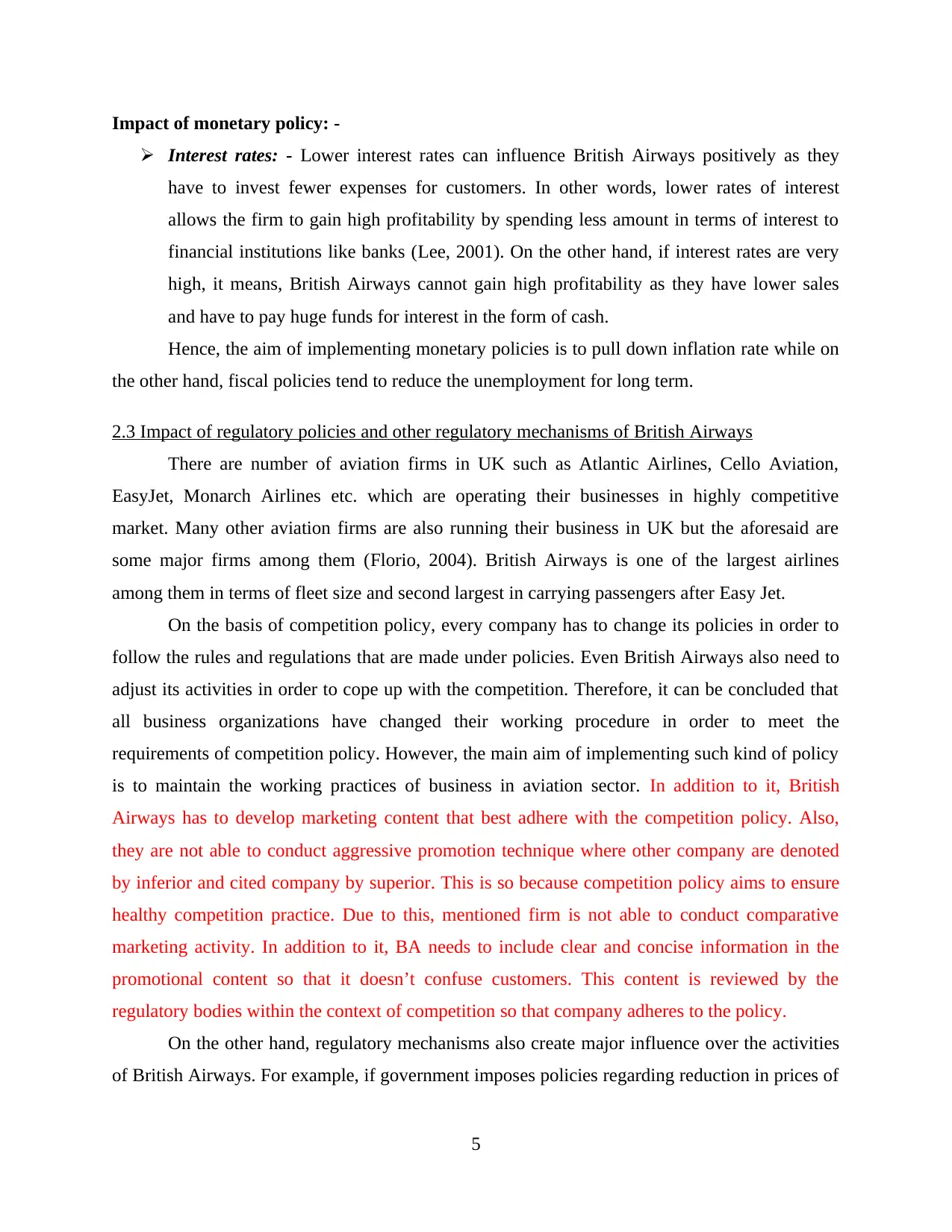
Impact of monetary policy: -
Interest rates: - Lower interest rates can influence British Airways positively as they
have to invest fewer expenses for customers. In other words, lower rates of interest
allows the firm to gain high profitability by spending less amount in terms of interest to
financial institutions like banks (Lee, 2001). On the other hand, if interest rates are very
high, it means, British Airways cannot gain high profitability as they have lower sales
and have to pay huge funds for interest in the form of cash.
Hence, the aim of implementing monetary policies is to pull down inflation rate while on
the other hand, fiscal policies tend to reduce the unemployment for long term.
2.3 Impact of regulatory policies and other regulatory mechanisms of British Airways
There are number of aviation firms in UK such as Atlantic Airlines, Cello Aviation,
EasyJet, Monarch Airlines etc. which are operating their businesses in highly competitive
market. Many other aviation firms are also running their business in UK but the aforesaid are
some major firms among them (Florio, 2004). British Airways is one of the largest airlines
among them in terms of fleet size and second largest in carrying passengers after Easy Jet.
On the basis of competition policy, every company has to change its policies in order to
follow the rules and regulations that are made under policies. Even British Airways also need to
adjust its activities in order to cope up with the competition. Therefore, it can be concluded that
all business organizations have changed their working procedure in order to meet the
requirements of competition policy. However, the main aim of implementing such kind of policy
is to maintain the working practices of business in aviation sector. In addition to it, British
Airways has to develop marketing content that best adhere with the competition policy. Also,
they are not able to conduct aggressive promotion technique where other company are denoted
by inferior and cited company by superior. This is so because competition policy aims to ensure
healthy competition practice. Due to this, mentioned firm is not able to conduct comparative
marketing activity. In addition to it, BA needs to include clear and concise information in the
promotional content so that it doesn’t confuse customers. This content is reviewed by the
regulatory bodies within the context of competition so that company adheres to the policy.
On the other hand, regulatory mechanisms also create major influence over the activities
of British Airways. For example, if government imposes policies regarding reduction in prices of
5
Interest rates: - Lower interest rates can influence British Airways positively as they
have to invest fewer expenses for customers. In other words, lower rates of interest
allows the firm to gain high profitability by spending less amount in terms of interest to
financial institutions like banks (Lee, 2001). On the other hand, if interest rates are very
high, it means, British Airways cannot gain high profitability as they have lower sales
and have to pay huge funds for interest in the form of cash.
Hence, the aim of implementing monetary policies is to pull down inflation rate while on
the other hand, fiscal policies tend to reduce the unemployment for long term.
2.3 Impact of regulatory policies and other regulatory mechanisms of British Airways
There are number of aviation firms in UK such as Atlantic Airlines, Cello Aviation,
EasyJet, Monarch Airlines etc. which are operating their businesses in highly competitive
market. Many other aviation firms are also running their business in UK but the aforesaid are
some major firms among them (Florio, 2004). British Airways is one of the largest airlines
among them in terms of fleet size and second largest in carrying passengers after Easy Jet.
On the basis of competition policy, every company has to change its policies in order to
follow the rules and regulations that are made under policies. Even British Airways also need to
adjust its activities in order to cope up with the competition. Therefore, it can be concluded that
all business organizations have changed their working procedure in order to meet the
requirements of competition policy. However, the main aim of implementing such kind of policy
is to maintain the working practices of business in aviation sector. In addition to it, British
Airways has to develop marketing content that best adhere with the competition policy. Also,
they are not able to conduct aggressive promotion technique where other company are denoted
by inferior and cited company by superior. This is so because competition policy aims to ensure
healthy competition practice. Due to this, mentioned firm is not able to conduct comparative
marketing activity. In addition to it, BA needs to include clear and concise information in the
promotional content so that it doesn’t confuse customers. This content is reviewed by the
regulatory bodies within the context of competition so that company adheres to the policy.
On the other hand, regulatory mechanisms also create major influence over the activities
of British Airways. For example, if government imposes policies regarding reduction in prices of
5
Paraphrase This Document
Need a fresh take? Get an instant paraphrase of this document with our AI Paraphraser
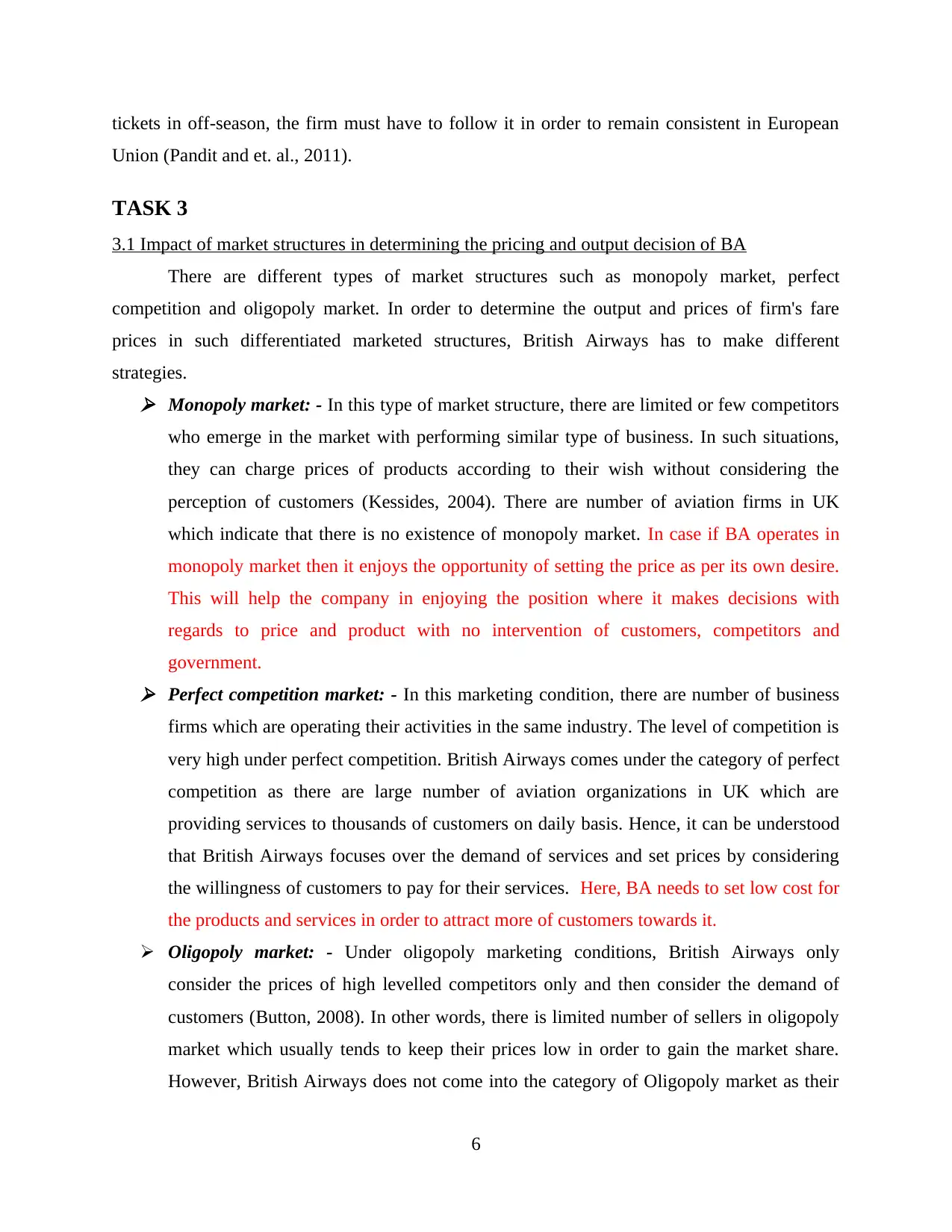
tickets in off-season, the firm must have to follow it in order to remain consistent in European
Union (Pandit and et. al., 2011).
TASK 3
3.1 Impact of market structures in determining the pricing and output decision of BA
There are different types of market structures such as monopoly market, perfect
competition and oligopoly market. In order to determine the output and prices of firm's fare
prices in such differentiated marketed structures, British Airways has to make different
strategies. Monopoly market: - In this type of market structure, there are limited or few competitors
who emerge in the market with performing similar type of business. In such situations,
they can charge prices of products according to their wish without considering the
perception of customers (Kessides, 2004). There are number of aviation firms in UK
which indicate that there is no existence of monopoly market. In case if BA operates in
monopoly market then it enjoys the opportunity of setting the price as per its own desire.
This will help the company in enjoying the position where it makes decisions with
regards to price and product with no intervention of customers, competitors and
government. Perfect competition market: - In this marketing condition, there are number of business
firms which are operating their activities in the same industry. The level of competition is
very high under perfect competition. British Airways comes under the category of perfect
competition as there are large number of aviation organizations in UK which are
providing services to thousands of customers on daily basis. Hence, it can be understood
that British Airways focuses over the demand of services and set prices by considering
the willingness of customers to pay for their services. Here, BA needs to set low cost for
the products and services in order to attract more of customers towards it.
Oligopoly market: - Under oligopoly marketing conditions, British Airways only
consider the prices of high levelled competitors only and then consider the demand of
customers (Button, 2008). In other words, there is limited number of sellers in oligopoly
market which usually tends to keep their prices low in order to gain the market share.
However, British Airways does not come into the category of Oligopoly market as their
6
Union (Pandit and et. al., 2011).
TASK 3
3.1 Impact of market structures in determining the pricing and output decision of BA
There are different types of market structures such as monopoly market, perfect
competition and oligopoly market. In order to determine the output and prices of firm's fare
prices in such differentiated marketed structures, British Airways has to make different
strategies. Monopoly market: - In this type of market structure, there are limited or few competitors
who emerge in the market with performing similar type of business. In such situations,
they can charge prices of products according to their wish without considering the
perception of customers (Kessides, 2004). There are number of aviation firms in UK
which indicate that there is no existence of monopoly market. In case if BA operates in
monopoly market then it enjoys the opportunity of setting the price as per its own desire.
This will help the company in enjoying the position where it makes decisions with
regards to price and product with no intervention of customers, competitors and
government. Perfect competition market: - In this marketing condition, there are number of business
firms which are operating their activities in the same industry. The level of competition is
very high under perfect competition. British Airways comes under the category of perfect
competition as there are large number of aviation organizations in UK which are
providing services to thousands of customers on daily basis. Hence, it can be understood
that British Airways focuses over the demand of services and set prices by considering
the willingness of customers to pay for their services. Here, BA needs to set low cost for
the products and services in order to attract more of customers towards it.
Oligopoly market: - Under oligopoly marketing conditions, British Airways only
consider the prices of high levelled competitors only and then consider the demand of
customers (Button, 2008). In other words, there is limited number of sellers in oligopoly
market which usually tends to keep their prices low in order to gain the market share.
However, British Airways does not come into the category of Oligopoly market as their
6
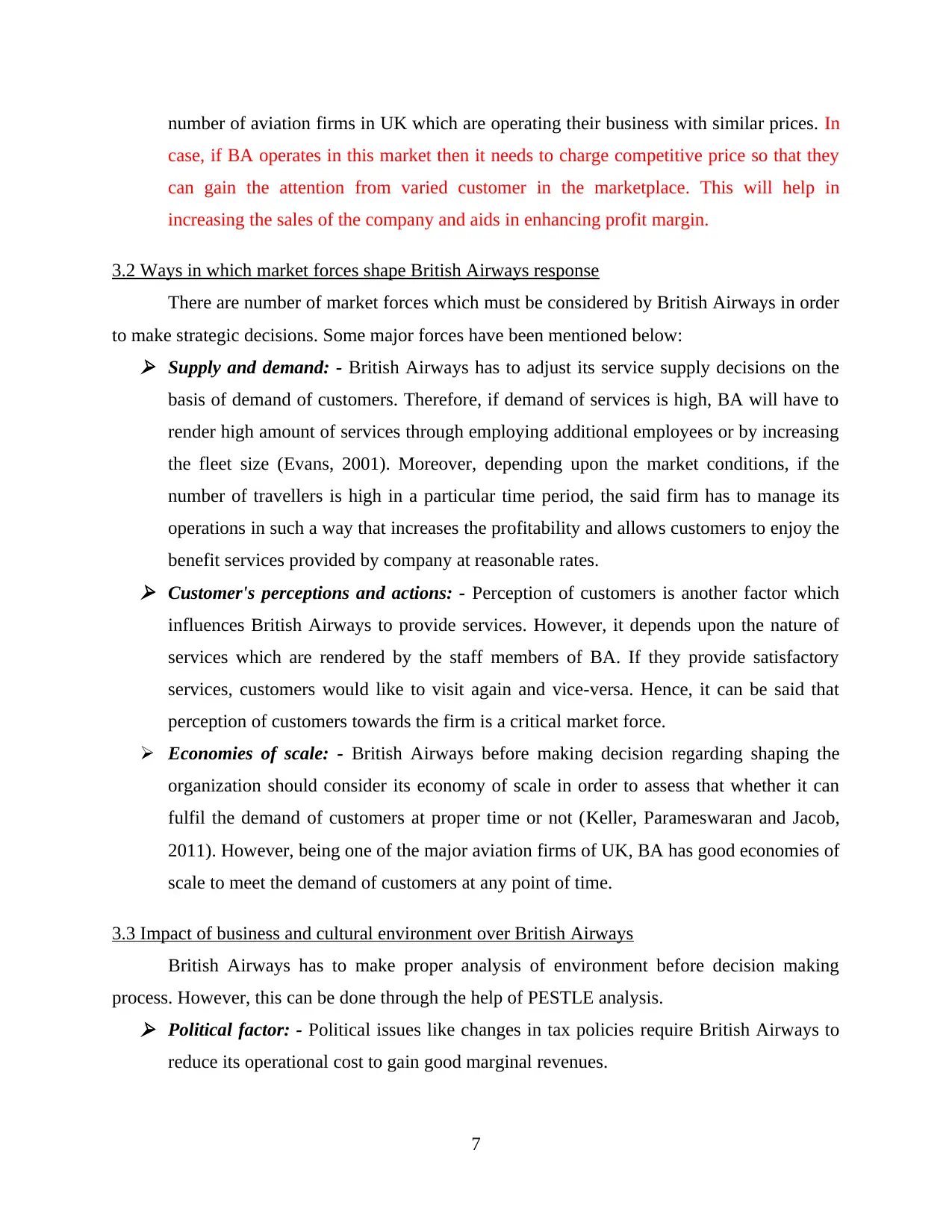
number of aviation firms in UK which are operating their business with similar prices. In
case, if BA operates in this market then it needs to charge competitive price so that they
can gain the attention from varied customer in the marketplace. This will help in
increasing the sales of the company and aids in enhancing profit margin.
3.2 Ways in which market forces shape British Airways response
There are number of market forces which must be considered by British Airways in order
to make strategic decisions. Some major forces have been mentioned below: Supply and demand: - British Airways has to adjust its service supply decisions on the
basis of demand of customers. Therefore, if demand of services is high, BA will have to
render high amount of services through employing additional employees or by increasing
the fleet size (Evans, 2001). Moreover, depending upon the market conditions, if the
number of travellers is high in a particular time period, the said firm has to manage its
operations in such a way that increases the profitability and allows customers to enjoy the
benefit services provided by company at reasonable rates. Customer's perceptions and actions: - Perception of customers is another factor which
influences British Airways to provide services. However, it depends upon the nature of
services which are rendered by the staff members of BA. If they provide satisfactory
services, customers would like to visit again and vice-versa. Hence, it can be said that
perception of customers towards the firm is a critical market force.
Economies of scale: - British Airways before making decision regarding shaping the
organization should consider its economy of scale in order to assess that whether it can
fulfil the demand of customers at proper time or not (Keller, Parameswaran and Jacob,
2011). However, being one of the major aviation firms of UK, BA has good economies of
scale to meet the demand of customers at any point of time.
3.3 Impact of business and cultural environment over British Airways
British Airways has to make proper analysis of environment before decision making
process. However, this can be done through the help of PESTLE analysis. Political factor: - Political issues like changes in tax policies require British Airways to
reduce its operational cost to gain good marginal revenues.
7
case, if BA operates in this market then it needs to charge competitive price so that they
can gain the attention from varied customer in the marketplace. This will help in
increasing the sales of the company and aids in enhancing profit margin.
3.2 Ways in which market forces shape British Airways response
There are number of market forces which must be considered by British Airways in order
to make strategic decisions. Some major forces have been mentioned below: Supply and demand: - British Airways has to adjust its service supply decisions on the
basis of demand of customers. Therefore, if demand of services is high, BA will have to
render high amount of services through employing additional employees or by increasing
the fleet size (Evans, 2001). Moreover, depending upon the market conditions, if the
number of travellers is high in a particular time period, the said firm has to manage its
operations in such a way that increases the profitability and allows customers to enjoy the
benefit services provided by company at reasonable rates. Customer's perceptions and actions: - Perception of customers is another factor which
influences British Airways to provide services. However, it depends upon the nature of
services which are rendered by the staff members of BA. If they provide satisfactory
services, customers would like to visit again and vice-versa. Hence, it can be said that
perception of customers towards the firm is a critical market force.
Economies of scale: - British Airways before making decision regarding shaping the
organization should consider its economy of scale in order to assess that whether it can
fulfil the demand of customers at proper time or not (Keller, Parameswaran and Jacob,
2011). However, being one of the major aviation firms of UK, BA has good economies of
scale to meet the demand of customers at any point of time.
3.3 Impact of business and cultural environment over British Airways
British Airways has to make proper analysis of environment before decision making
process. However, this can be done through the help of PESTLE analysis. Political factor: - Political issues like changes in tax policies require British Airways to
reduce its operational cost to gain good marginal revenues.
7
⊘ This is a preview!⊘
Do you want full access?
Subscribe today to unlock all pages.

Trusted by 1+ million students worldwide
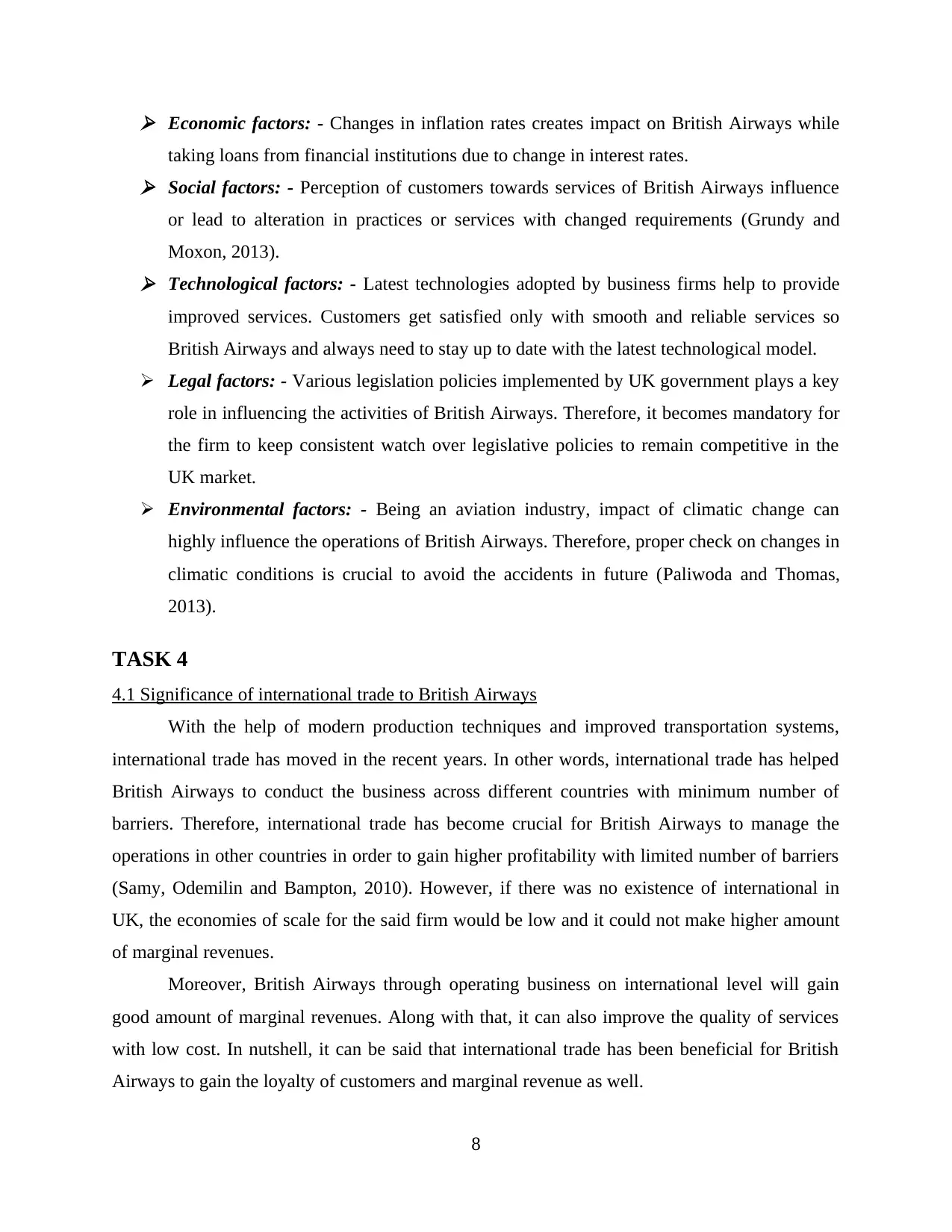
Economic factors: - Changes in inflation rates creates impact on British Airways while
taking loans from financial institutions due to change in interest rates. Social factors: - Perception of customers towards services of British Airways influence
or lead to alteration in practices or services with changed requirements (Grundy and
Moxon, 2013). Technological factors: - Latest technologies adopted by business firms help to provide
improved services. Customers get satisfied only with smooth and reliable services so
British Airways and always need to stay up to date with the latest technological model.
Legal factors: - Various legislation policies implemented by UK government plays a key
role in influencing the activities of British Airways. Therefore, it becomes mandatory for
the firm to keep consistent watch over legislative policies to remain competitive in the
UK market.
Environmental factors: - Being an aviation industry, impact of climatic change can
highly influence the operations of British Airways. Therefore, proper check on changes in
climatic conditions is crucial to avoid the accidents in future (Paliwoda and Thomas,
2013).
TASK 4
4.1 Significance of international trade to British Airways
With the help of modern production techniques and improved transportation systems,
international trade has moved in the recent years. In other words, international trade has helped
British Airways to conduct the business across different countries with minimum number of
barriers. Therefore, international trade has become crucial for British Airways to manage the
operations in other countries in order to gain higher profitability with limited number of barriers
(Samy, Odemilin and Bampton, 2010). However, if there was no existence of international in
UK, the economies of scale for the said firm would be low and it could not make higher amount
of marginal revenues.
Moreover, British Airways through operating business on international level will gain
good amount of marginal revenues. Along with that, it can also improve the quality of services
with low cost. In nutshell, it can be said that international trade has been beneficial for British
Airways to gain the loyalty of customers and marginal revenue as well.
8
taking loans from financial institutions due to change in interest rates. Social factors: - Perception of customers towards services of British Airways influence
or lead to alteration in practices or services with changed requirements (Grundy and
Moxon, 2013). Technological factors: - Latest technologies adopted by business firms help to provide
improved services. Customers get satisfied only with smooth and reliable services so
British Airways and always need to stay up to date with the latest technological model.
Legal factors: - Various legislation policies implemented by UK government plays a key
role in influencing the activities of British Airways. Therefore, it becomes mandatory for
the firm to keep consistent watch over legislative policies to remain competitive in the
UK market.
Environmental factors: - Being an aviation industry, impact of climatic change can
highly influence the operations of British Airways. Therefore, proper check on changes in
climatic conditions is crucial to avoid the accidents in future (Paliwoda and Thomas,
2013).
TASK 4
4.1 Significance of international trade to British Airways
With the help of modern production techniques and improved transportation systems,
international trade has moved in the recent years. In other words, international trade has helped
British Airways to conduct the business across different countries with minimum number of
barriers. Therefore, international trade has become crucial for British Airways to manage the
operations in other countries in order to gain higher profitability with limited number of barriers
(Samy, Odemilin and Bampton, 2010). However, if there was no existence of international in
UK, the economies of scale for the said firm would be low and it could not make higher amount
of marginal revenues.
Moreover, British Airways through operating business on international level will gain
good amount of marginal revenues. Along with that, it can also improve the quality of services
with low cost. In nutshell, it can be said that international trade has been beneficial for British
Airways to gain the loyalty of customers and marginal revenue as well.
8
Paraphrase This Document
Need a fresh take? Get an instant paraphrase of this document with our AI Paraphraser
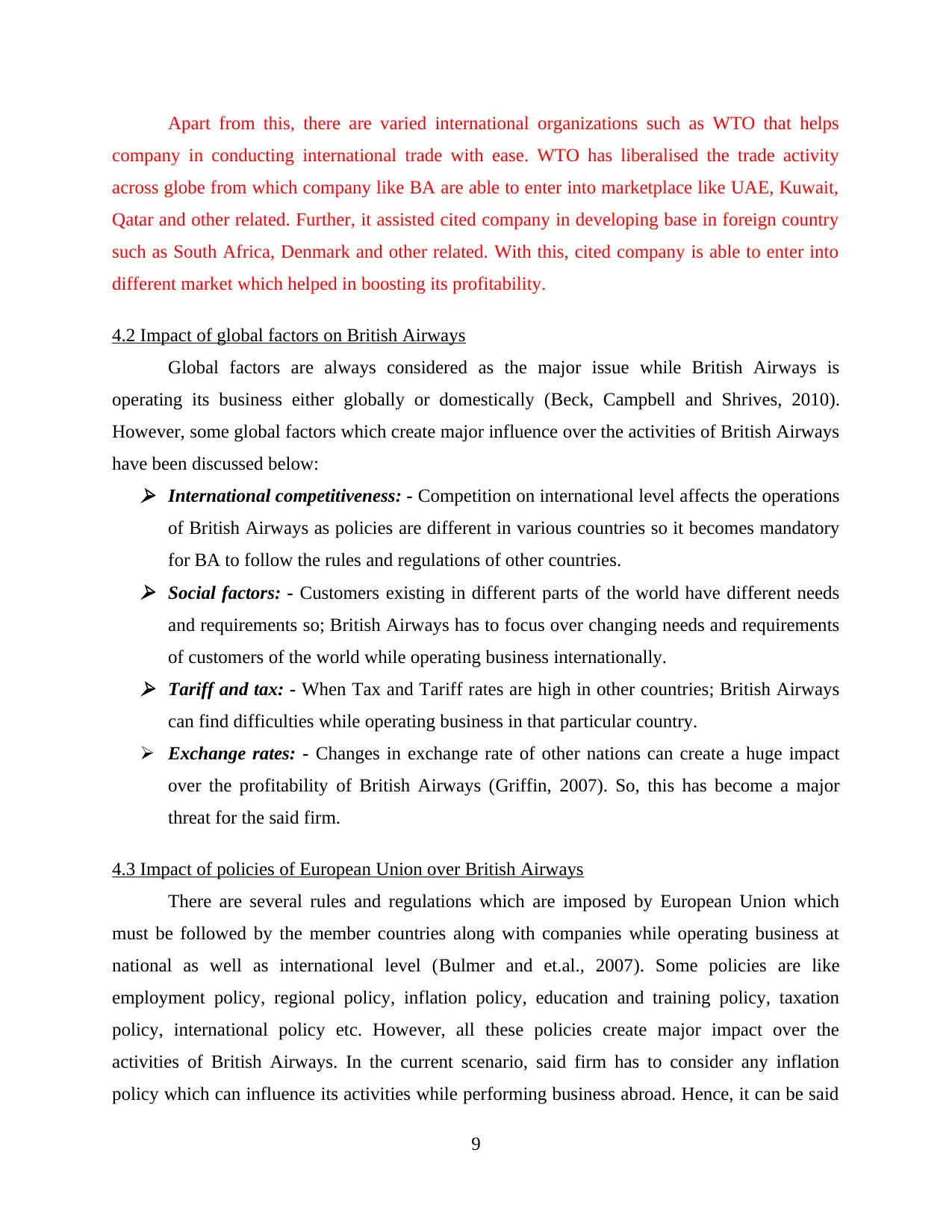
Apart from this, there are varied international organizations such as WTO that helps
company in conducting international trade with ease. WTO has liberalised the trade activity
across globe from which company like BA are able to enter into marketplace like UAE, Kuwait,
Qatar and other related. Further, it assisted cited company in developing base in foreign country
such as South Africa, Denmark and other related. With this, cited company is able to enter into
different market which helped in boosting its profitability.
4.2 Impact of global factors on British Airways
Global factors are always considered as the major issue while British Airways is
operating its business either globally or domestically (Beck, Campbell and Shrives, 2010).
However, some global factors which create major influence over the activities of British Airways
have been discussed below: International competitiveness: - Competition on international level affects the operations
of British Airways as policies are different in various countries so it becomes mandatory
for BA to follow the rules and regulations of other countries. Social factors: - Customers existing in different parts of the world have different needs
and requirements so; British Airways has to focus over changing needs and requirements
of customers of the world while operating business internationally. Tariff and tax: - When Tax and Tariff rates are high in other countries; British Airways
can find difficulties while operating business in that particular country.
Exchange rates: - Changes in exchange rate of other nations can create a huge impact
over the profitability of British Airways (Griffin, 2007). So, this has become a major
threat for the said firm.
4.3 Impact of policies of European Union over British Airways
There are several rules and regulations which are imposed by European Union which
must be followed by the member countries along with companies while operating business at
national as well as international level (Bulmer and et.al., 2007). Some policies are like
employment policy, regional policy, inflation policy, education and training policy, taxation
policy, international policy etc. However, all these policies create major impact over the
activities of British Airways. In the current scenario, said firm has to consider any inflation
policy which can influence its activities while performing business abroad. Hence, it can be said
9
company in conducting international trade with ease. WTO has liberalised the trade activity
across globe from which company like BA are able to enter into marketplace like UAE, Kuwait,
Qatar and other related. Further, it assisted cited company in developing base in foreign country
such as South Africa, Denmark and other related. With this, cited company is able to enter into
different market which helped in boosting its profitability.
4.2 Impact of global factors on British Airways
Global factors are always considered as the major issue while British Airways is
operating its business either globally or domestically (Beck, Campbell and Shrives, 2010).
However, some global factors which create major influence over the activities of British Airways
have been discussed below: International competitiveness: - Competition on international level affects the operations
of British Airways as policies are different in various countries so it becomes mandatory
for BA to follow the rules and regulations of other countries. Social factors: - Customers existing in different parts of the world have different needs
and requirements so; British Airways has to focus over changing needs and requirements
of customers of the world while operating business internationally. Tariff and tax: - When Tax and Tariff rates are high in other countries; British Airways
can find difficulties while operating business in that particular country.
Exchange rates: - Changes in exchange rate of other nations can create a huge impact
over the profitability of British Airways (Griffin, 2007). So, this has become a major
threat for the said firm.
4.3 Impact of policies of European Union over British Airways
There are several rules and regulations which are imposed by European Union which
must be followed by the member countries along with companies while operating business at
national as well as international level (Bulmer and et.al., 2007). Some policies are like
employment policy, regional policy, inflation policy, education and training policy, taxation
policy, international policy etc. However, all these policies create major impact over the
activities of British Airways. In the current scenario, said firm has to consider any inflation
policy which can influence its activities while performing business abroad. Hence, it can be said
9
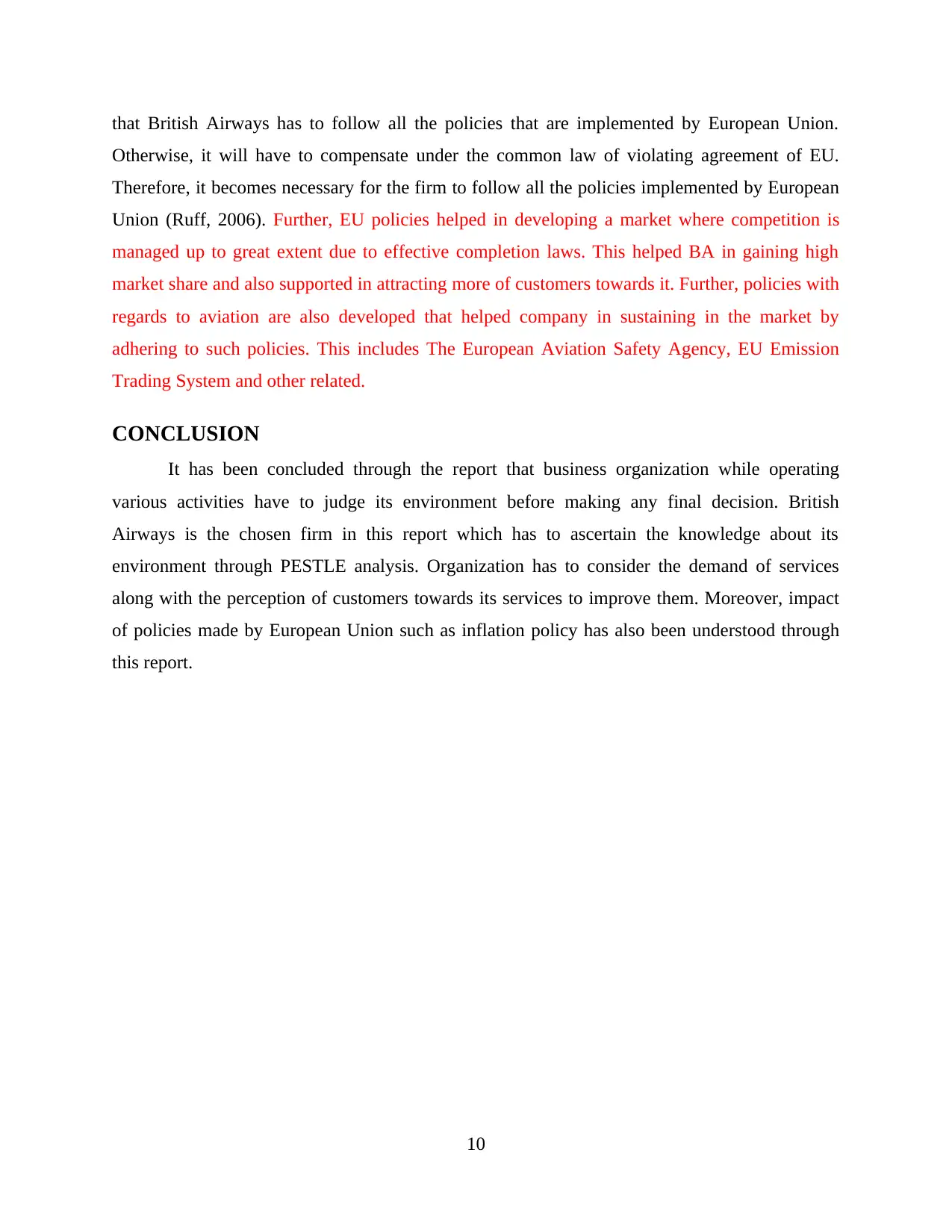
that British Airways has to follow all the policies that are implemented by European Union.
Otherwise, it will have to compensate under the common law of violating agreement of EU.
Therefore, it becomes necessary for the firm to follow all the policies implemented by European
Union (Ruff, 2006). Further, EU policies helped in developing a market where competition is
managed up to great extent due to effective completion laws. This helped BA in gaining high
market share and also supported in attracting more of customers towards it. Further, policies with
regards to aviation are also developed that helped company in sustaining in the market by
adhering to such policies. This includes The European Aviation Safety Agency, EU Emission
Trading System and other related.
CONCLUSION
It has been concluded through the report that business organization while operating
various activities have to judge its environment before making any final decision. British
Airways is the chosen firm in this report which has to ascertain the knowledge about its
environment through PESTLE analysis. Organization has to consider the demand of services
along with the perception of customers towards its services to improve them. Moreover, impact
of policies made by European Union such as inflation policy has also been understood through
this report.
10
Otherwise, it will have to compensate under the common law of violating agreement of EU.
Therefore, it becomes necessary for the firm to follow all the policies implemented by European
Union (Ruff, 2006). Further, EU policies helped in developing a market where competition is
managed up to great extent due to effective completion laws. This helped BA in gaining high
market share and also supported in attracting more of customers towards it. Further, policies with
regards to aviation are also developed that helped company in sustaining in the market by
adhering to such policies. This includes The European Aviation Safety Agency, EU Emission
Trading System and other related.
CONCLUSION
It has been concluded through the report that business organization while operating
various activities have to judge its environment before making any final decision. British
Airways is the chosen firm in this report which has to ascertain the knowledge about its
environment through PESTLE analysis. Organization has to consider the demand of services
along with the perception of customers towards its services to improve them. Moreover, impact
of policies made by European Union such as inflation policy has also been understood through
this report.
10
⊘ This is a preview!⊘
Do you want full access?
Subscribe today to unlock all pages.

Trusted by 1+ million students worldwide
1 out of 14
Related Documents
Your All-in-One AI-Powered Toolkit for Academic Success.
+13062052269
info@desklib.com
Available 24*7 on WhatsApp / Email
![[object Object]](/_next/static/media/star-bottom.7253800d.svg)
Unlock your academic potential
Copyright © 2020–2025 A2Z Services. All Rights Reserved. Developed and managed by ZUCOL.





